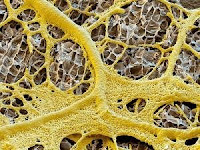NewScientist - July 8, 2009, by Justin Mullins
Slime mould feeding on the surface of an almond. These cunning organisms could be the missing link in memory circuits (Image: Eye of Science/Science Photo Library
EVER had the feeling something is missing? If so, you're in good company. Dmitri Mendeleev did in 1869 when he noticed four gaps in his periodic table. They turned out to be the undiscovered elements scandium, gallium, technetium and germanium. Paul Dirac did in 1929 when he looked deep into the quantum-mechanical equation he had formulated to describe the electron. Besides the electron, he saw something else that looked rather like it, but different. It was only in 1932, when the electron's antimatter sibling, the positron, was sighted in cosmic rays that such a thing was found to exist.
In 1971, Leon Chua had that feeling. A young electronics engineer with a penchant for mathematics at the University of California, Berkeley, he was fascinated by the fact that electronics had no rigorous mathematical foundation. So like any diligent scientist, he set about trying to derive one.
Were this an article about a conventional breakthrough in electronics, that would be the end of the story. Better memory materials alone do not set the pulse racing. We have come to regard ever zippier consumer electronics as a basic right, and are notoriously insouciant about the improvements in basic physics that make them possible. What's different about memristors?
And he found something missing: a fourth basic circuit element besides the standard trio of resistor, capacitor and inductor. Chua dubbed it the "memristor". The only problem was that as far as Chua or anyone else could see, memristors did not actually exist.
Read entire story>>
Follow me on Twitter. Technological Singularity and Futurism is updated often; the easiest way to get your regular dose is by subscribing to our news feed. Stay on top of all our updates by subscribing now via RSS or Email.









0 comments :
Post a Comment